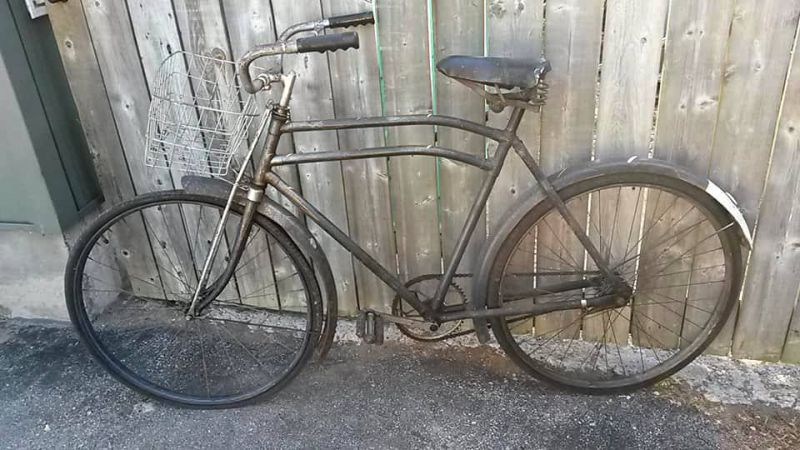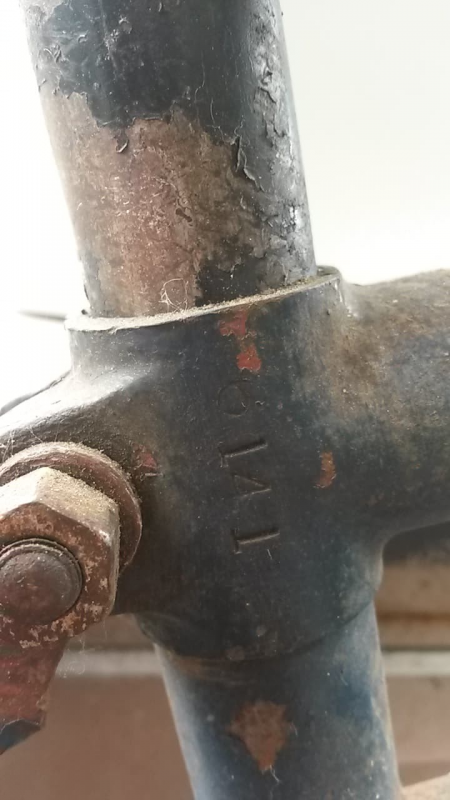CCM Cleveland???
I'm looking at what looks like a double bar CCM Clevland but the serial # is not the right format so thinking it might be something else or some sort of hodge-podge.
Looking for advise, I'd like to buy it from a guy and restore, but we are trying to determine what it is!







The lugs on the headtube, and cottered cranks make me think its something English. Are there any other markings on the frame, or hubs?
Front hub: Falcon Made in Canada
Rear Hub B.S.A
Crank W.B.
It looks like something that could have been made by Standard Cycle Products of Toronto. It is definitely not a CCM Cleveland.
John Williamson
It looks a lot like a couple of Supercyle Motorbikes that have surfaced in the past.
http://vintageccm.com/content/1930s-supercycle-twin-bar
John, I agree with T-MAR. In the past, I owned two of those frame types. Both made for Eatons, called the "Eatonia". The company that made those frames was called Tru-Well (the name should be stamped on the back wheel stay, but you will need to remove the wheel to see it). See picture 1. Tru-well exported those frames to Canada and the US, which were then sold to department stores such as Canadian Tires, Eatons, Simpsons, the Norman Bicycle Cie, etc. See picture 2 and 3. The rest of the bicycle would then be assembled by a third (subcontracted) party to finish the bike. Often these bicycles were budject bicycles. Of particular interest, notice the upper rear wheel stay on my Eatonia (see picture 4). That model was called the "Water fall" wheel stay.
I would estimate the year to be mid-30s to mid-40s.
Hope this helps
Marc from Ottawa.
here is picture 4
If you count the number of spokes on the wheels, you will see that in the catalogue pictures the wheels are spoked 32/40, which is typical of English-made bicycles. The wheels on the bicycle in the post are 36/36 which strongly suggests that the bicycle is Canadian. My dad had a SCP double bar bike that looked almost the same as the mystery bike.
John Williamson
Thanks for the input. Haven't seen any pics of an SCP double bar,it seems to be hard to find info about that company. but all of the information is great. I wish it had a headbadge! In any case I think it would be an interesting project.
Marc, with all due respect, Tru-Wel is not the name of the frame/bicycle manufacturer. It is the brand name of the tubing used in the frame's manufacture. Tru-Wel was seamed tubing manufactured by electrical resistance welding of tubes formed from flat stock. This was much less expensive than drawing seamless tubing from billet. The company that produced Tru-Wel tubing was Tube Products Ltd. of Oldbury, Birmingahm, England. While bicycle tubing was a major product, they also produced tubing for the automotive, chemical and furniture industries, among others.
The company was founded in 1927, so any frame found with Tru-Wel impressions is no older than that. The company was formed as part of the Tube Investments (TI) group which also owned Accles & Pollock, who produced the seamless, chromium-molybdenum tubing used by CCM in their Flyer models. Tube Products still exists, via a division established in India in 1955.
While it's possible that they diversified into frame manufacture, I can find no evidence of this. 1940s and 1950s literature, mentions only tubing supplied to other industries. In fact, it appears that up until at least 1948, they only manufactured the rear triangle stays for bicycle frames, as an advertisement from that year (attached) mentions only "cycle stays". One would think that they would have used a more broader, more generic termininolgy, had they manufactured the main tubes or even frames. Certainly, they later diversfied in the main triangle tubes, based on the decals I've seen on 1960s and 1970s bicycles.
As part of TI conglomerate, they would have been one of the corporation's tube suppliers to the numerous bicycle companies also owned by TI. This started in 1946 with the purchase of Hercules in 1946 and continued thoughout the 1950s, with the 1960 acquistion of Raleigh establishing TI as the dominant force in the British cycle industry.
So, while the Tru-Wel did supply tubing to the cycle industry, I've found no evidence that they actually manufactured frames. While a non-bnadged frame with Tru-Wel could have been manufactured in England, it is just as likely that it could have been manufactured in Canada, as other TI companies supplied tubing to Canadian bicycle manufactuers. While John has a point about the spoke count, wheels are also one of the most frequently replaced items on a bicycle of this age. The absence of a head badge complicates matters and without one it is impossible to provide a definitive answer.
Regarding the age of the bicycle, the crankset may provide a clue, assuming it is original. The chain ring pattern looks like one used by Williams, a Brtish crankset manufacturer. Typically, they stamped their crankarms and chain rings with a trademark and date code. The trademark is a sword with the initals EBW and I'm wondering is the BW referred to by the OP is a partial EBW? In the attached picture, the date code is the 'Y' positioned below the trademark and represents 1936. Starting in 1938, they commenced a new sequence of dual letter date codes with AA = 1938, AB = 1939, AC =1939, etc. The only letters not used in the Williams date codes were Q, R and, V. O was used in the first sequence, but discontinued starting with the second sequence.
I don't recognize the crankarm logo. It almost looks hand engraved.
Thanks for the clarification T-Mar, much appreciated. I wonder if it was Raleigh or BSA who purchased the tubes from Tru-Wel. I would assume that they procuded bike frames for multiple cies.